
Triathlon training schedule for beginners
🚀 Dreamed of doing a triathlon but have NO idea where to start? You’re not alone. And for many newbies to the sport of triathlon, it can be pretty overwhelming thinking you have to learn all three disciplines in order combine them and crush a race! But, what if i told you a structured training plan under the right guidance could turn you from beginner to Triathlon finisher.
Consider the exhilaration when your feet cross that finish line and you realize everything inside of you has been stretched to new horizons. The pride in all those early mornings, the sweat of putting everything into training and now joining a rarefied group who complete this ultimate test of human endurance. It’s all within your reach! This all-inclusive guide will help you bridge the gap from beginner to triathlete with tips on training and successful walk-throughs of each leg of a race. Whether you are adding to your base of endurance training, or simply refining the art that is transitions: we gotchu every step of the way.
Triathlon training schedule for beginners
Excited to start this incredible journey? We go through the fundamental parts of triathlon training together, building up from assuming basic knowledge to each skill. In this blog, we are breaking it all down to help you ace the swim, bike and run sections of your triathlon with optimal tips on nutrition & race day strategies. There we go, put on your shoes and set up those goggles & diving caps because you are ready to begin the ultimate journey into triathlon victory! 💪
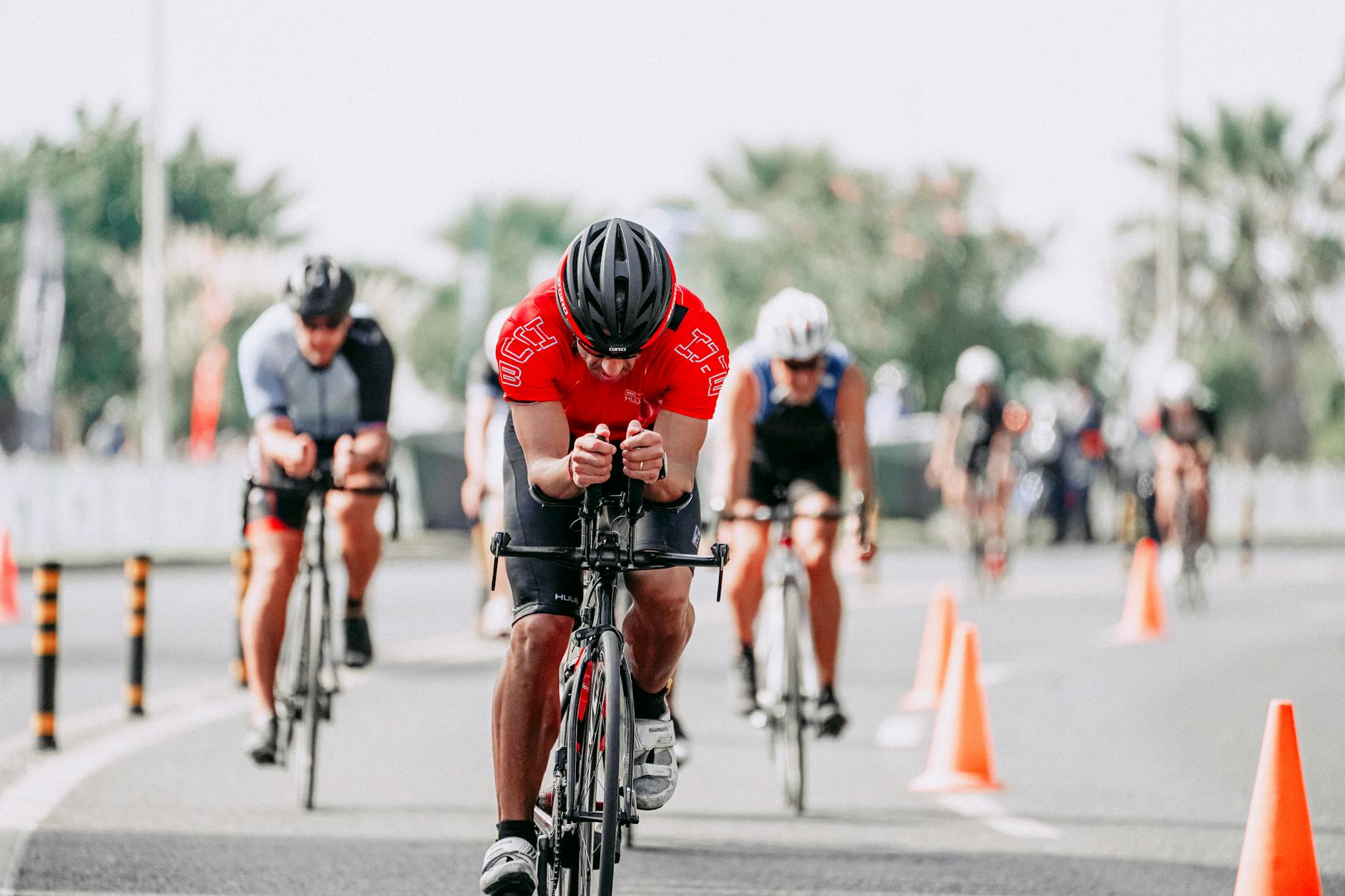
Triathlon training schedule for beginners
Understanding Triathlon Basics
A triathlon is a multisport event that combines swimming, cycling, and running in one race. Before diving into your training, it’s crucial to understand the fundamentals of this challenging sport.
Components of a triathlon
A typical triathlon consists of three disciplines:
- Swim
- Bike
- Run
These events are completed in sequence, with transitions between each discipline. The most common triathlon distances are:
| Distance | Swim | Bike | Run |
|---|---|---|---|
| Sprint | 750m | 20km | 5km |
| Olympic | 1.5km | 40km | 10km |
| Half Ironman | 1.9km | 90km | 21.1km |
| Ironman | 3.8km | 180km | 42.2km |
Essential gear for beginners
As a beginner, you’ll need some basic equipment to get started:
- Swimwear and goggles
- Road or triathlon bike
- Running shoes
- Helmet (mandatory for the bike leg)
- Comfortable clothing for cycling and running
Setting realistic goals
When preparing for your first triathlon:
- Choose a sprint distance race
- Allow at least 12 weeks for training
- Focus on finishing, not on time
- Set small, achievable milestones for each discipline
With these basics in mind, you’re ready to start building your endurance base and working on specific techniques for each discipline.

Triathlon training schedule for beginners
Building Your Endurance Base
Now that we’ve covered the basics of triathlons, let’s focus on building your endurance base – the foundation of your triathlon journey.
Developing cardiovascular fitness
Building cardiovascular fitness is crucial for triathletes. Start with low-intensity workouts and gradually increase duration and intensity. Here’s a sample weekly plan:
| Day | Activity | Duration |
|---|---|---|
| Mon | Swim | 30 min |
| Wed | Bike | 45 min |
| Fri | Run | 30 min |
| Sat | Choice | 60 min |
Creating a consistent training routine
Consistency is key in triathlon training. Establish a routine that fits your schedule and stick to it. Some tips for maintaining consistency:
- Set realistic goals
- Track your progress
- Find a training buddy
- Join a local triathlon club
Balancing work, life, and training
Balancing triathlon training with work and personal life can be challenging. Here are some strategies to help:
- Prioritize your workouts
- Use lunch breaks for short sessions
- Combine social activities with training
- Communicate with family and friends about your goals
Remember, building endurance takes time. Be patient and focus on gradual improvement. As you progress, you’ll notice increased stamina across all three disciplines. Next, we’ll delve into mastering the swim portion of your triathlon training.
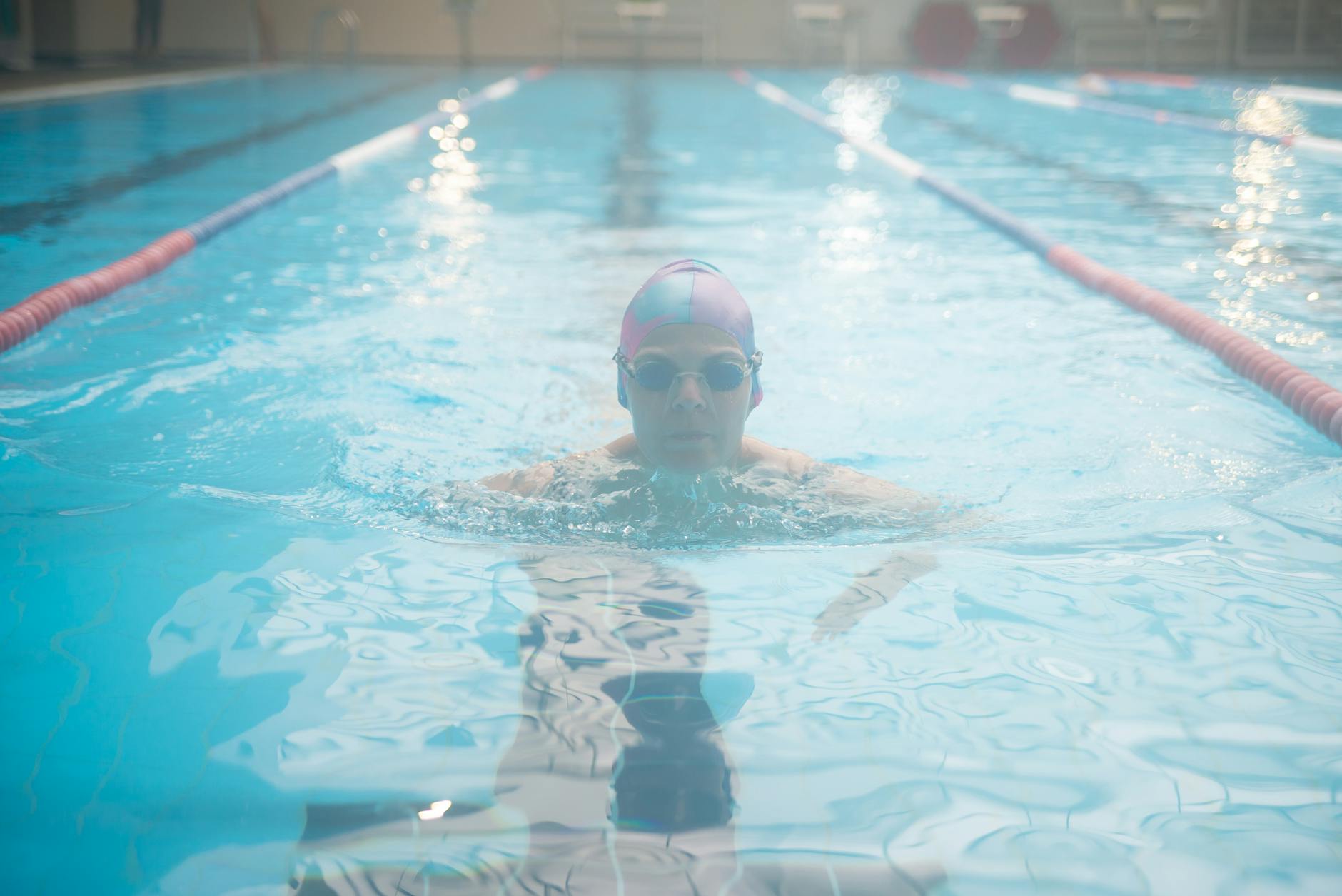
Triathlon training schedule for beginners
Mastering the Swim
Now that we’ve covered the basics of building your endurance, let’s dive into mastering the swim portion of your triathlon. This crucial first leg can set the tone for your entire race.
A. Improving swim technique
To become a more efficient swimmer, focus on these key elements:
- Body position: Keep your body horizontal and streamlined
- Stroke mechanics: Practice proper arm pull and recovery
- Breathing: Develop a consistent bilateral breathing pattern
- Kick: Use a steady, controlled kick to maintain balance
B. Open water swimming tips
| Tip | Description |
|---|---|
| Sighting | Practice looking forward every 6-8 strokes to stay on course |
| Drafting | Swim close behind or beside another swimmer to conserve energy |
| Start position | Position yourself based on your swimming ability and comfort level |
C. Building swim endurance
Incorporate these workouts into your training:
- Pyramid sets (e.g., 50m, 100m, 150m, 200m, 150m, 100m, 50m)
- Long, slow distance swims
- Interval training with varied intensities
- Drills focusing on technique and efficiency
D. Transitioning from pool to open water
As you prepare for race day, gradually shift your training from the pool to open water. Practice in conditions similar to your race venue, focusing on:
- Acclimatizing to water temperature
- Swimming without lane lines or walls
- Dealing with currents, waves, and limited visibility
With consistent practice and these strategies, you’ll be well-prepared for the swim leg of your triathlon. Next, we’ll explore how to conquer the bike portion of the race.
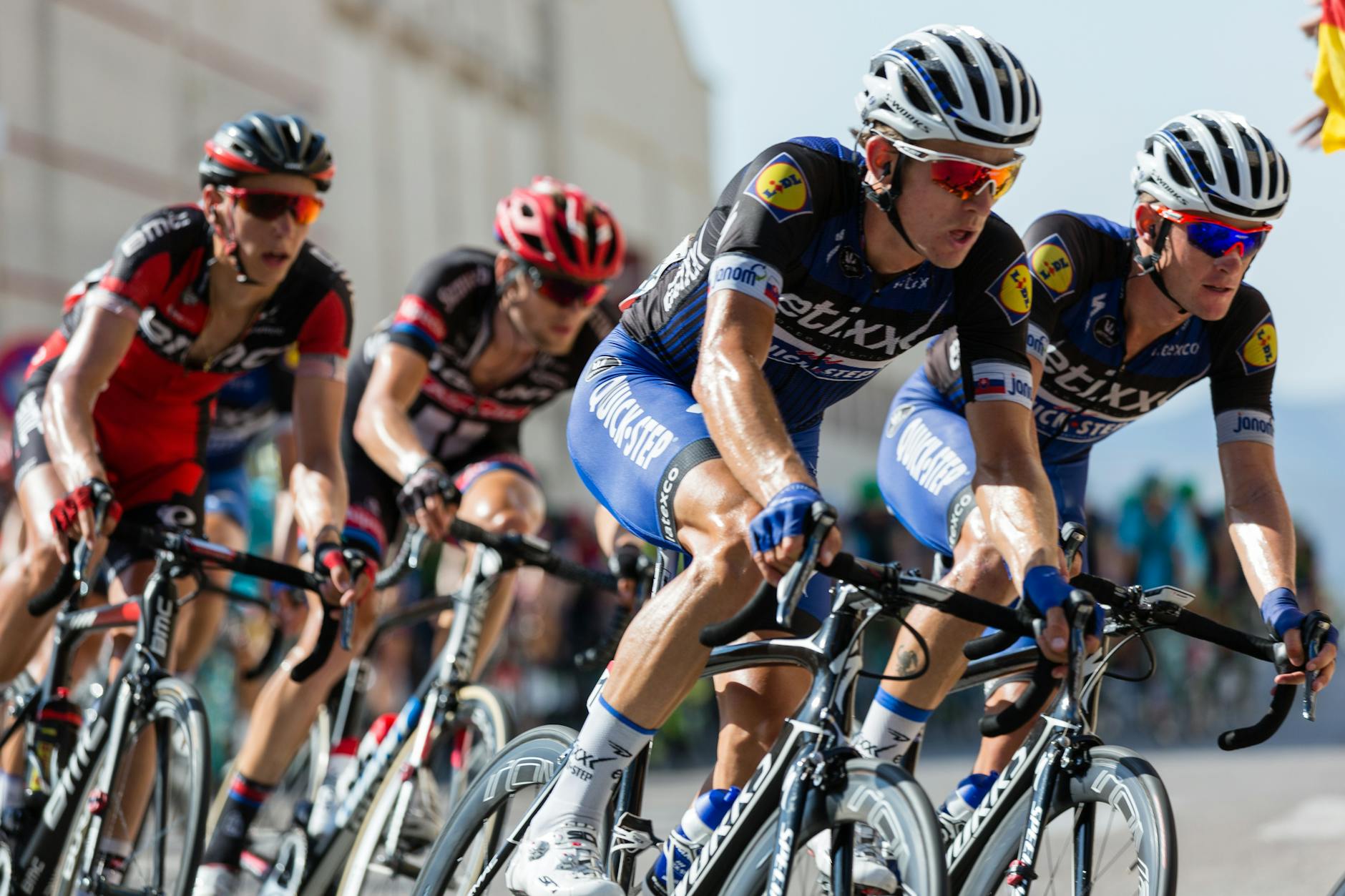
Triathlon training schedule for beginners
Conquering the Bike Leg
Now that we’ve covered the swim portion, let’s dive into the bike leg of your triathlon journey. This crucial segment can make or break your race, so it’s essential to master it.
A. Choosing the right bike
Selecting the appropriate bike is fundamental to your success. Here’s a quick comparison of bike types:
| Bike Type | Pros | Cons |
|---|---|---|
| Road Bike | Lightweight, versatile | Less aerodynamic |
| Triathlon Bike | Aerodynamic, efficient | Expensive, less comfortable |
| Hybrid Bike | Comfortable, affordable | Slower, heavier |
For beginners, a well-fitted road bike is often the best choice, offering a balance of speed and comfort.
B. Proper cycling form and technique
Maintaining proper form is crucial for efficiency and injury prevention. Key points include:
- Keep a slight bend in your elbows
- Engage your core for stability
- Pedal in smooth, circular motions
C. Building cycling endurance
To build endurance:
- Start with shorter rides and gradually increase distance
- Incorporate interval training for speed and power
- Practice hill climbs to build strength
D. Incorporating brick workouts
Brick workouts combine cycling and running, simulating race conditions. Start with short bike-run combinations and progressively increase duration. This practice helps your body adapt to the transition between disciplines.
As you master the bike leg, you’ll be well-prepared for the final challenge: the run. Next, we’ll explore strategies to perfect your running technique and endurance for the triathlon’s last segment.

Triathlon training schedule for beginners
Perfecting the Run
Now that we’ve covered cycling, let’s focus on the final leg of the triathlon: the run. Mastering this segment is crucial for a strong finish.
A. Proper running form for triathletes
Efficient running form is essential for triathletes, especially after swimming and cycling. Key elements include:
- Upright posture
- Relaxed shoulders
- Arms swinging naturally at 90-degree angles
- Mid-foot strike
- Quick cadence (aim for 180 steps per minute)
| Form Element | Description | Benefit |
|---|---|---|
| Upright posture | Keep your back straight and head up | Improves breathing and reduces fatigue |
| Mid-foot strike | Land on the middle of your foot | Reduces impact and increases efficiency |
| Quick cadence | Aim for 180 steps per minute | Improves speed and reduces injury risk |
B. Building run endurance
To improve your running endurance:
- Gradually increase weekly mileage
- Incorporate long, slow runs
- Add interval training for speed
- Practice brick workouts (cycling followed by running)
C. Injury prevention strategies
Prevent running injuries with these strategies:
- Proper warm-up and cool-down
- Regular stretching and mobility exercises
- Strength training, focusing on core and leg muscles
- Gradual increase in training intensity
- Adequate rest and recovery
Next, we’ll explore the crucial aspects of nutrition and hydration to fuel your triathlon journey.
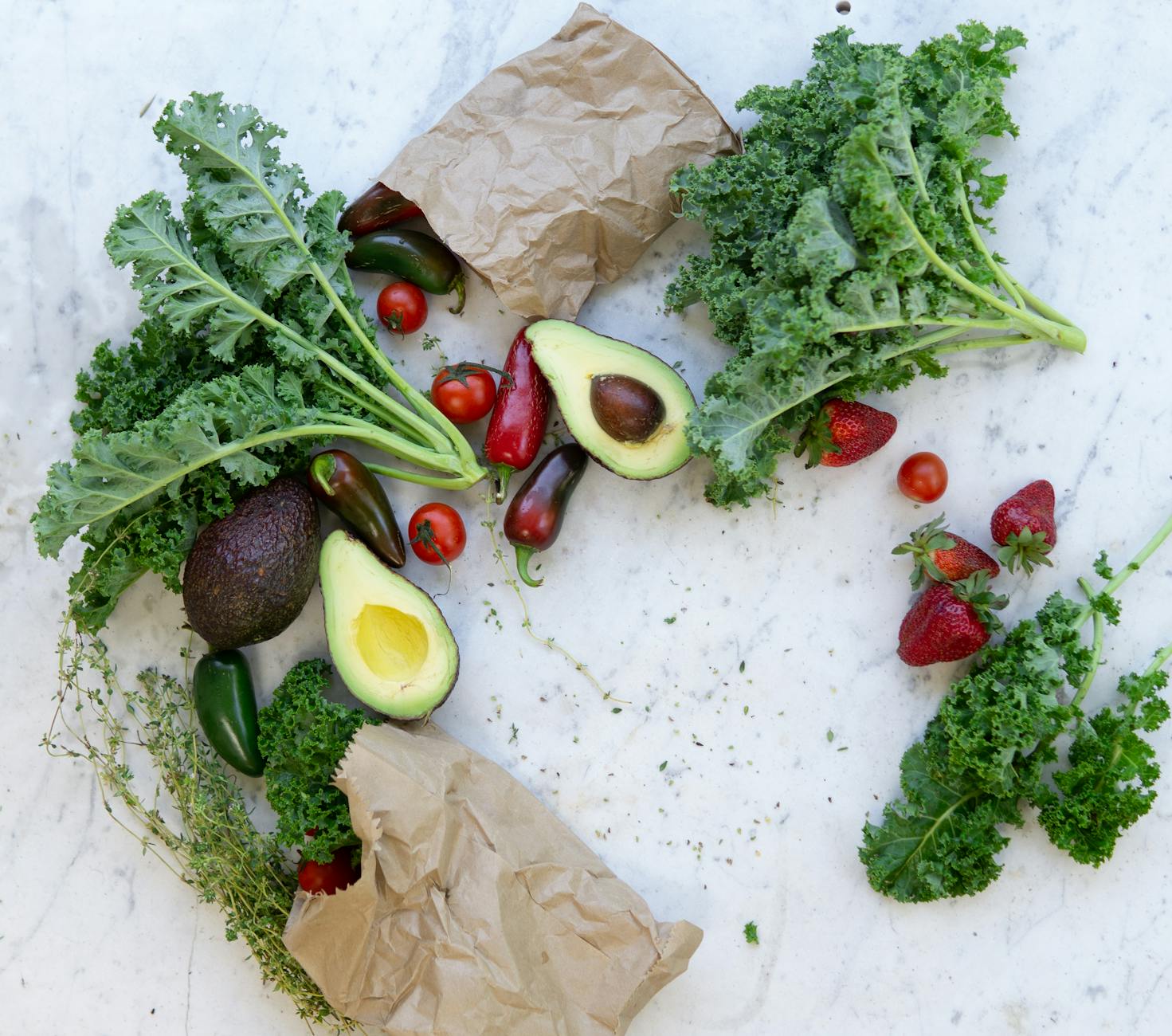
Triathlon training schedule for beginners
Nutrition and Hydration Strategies
Fueling for training sessions
Proper nutrition is crucial for successful triathlon training. Aim to consume a balanced mix of carbohydrates, proteins, and healthy fats. Here’s a simple guideline for fueling your workouts:
- Pre-workout: Eat a light meal rich in complex carbohydrates 2-3 hours before training
- During workout: For sessions longer than 90 minutes, consume 30-60g of carbohydrates per hour
- Post-workout: Refuel with a 3:1 ratio of carbohydrates to protein within 30 minutes
Race day nutrition plan
Your race day nutrition plan should be practiced during training to avoid surprises. Here’s a basic plan:
| Timing | Nutrition |
|---|---|
| 2-3 hours before | Light, carb-rich meal (e.g., oatmeal with banana) |
| 15-30 minutes before | Energy gel or sports drink |
| During race | 30-60g carbs/hour (gels, bars, or sports drinks) |
| Post-race | Balanced meal with carbs and protein |
Hydration tips for all three disciplines
Proper hydration is essential for performance and safety. Here are key tips for each discipline:
- Swim: Drink water before and after, as you can’t hydrate during the swim
- Bike: Aim for 1-2 bottles per hour, depending on conditions
- Run: Utilize aid stations, drinking small amounts frequently
Remember to practice your nutrition and hydration strategy during training. This will help you find what works best for your body and prevent digestive issues on race day. With a solid nutrition and hydration plan, you’ll be well-prepared to tackle the physical demands of your first triathlon.
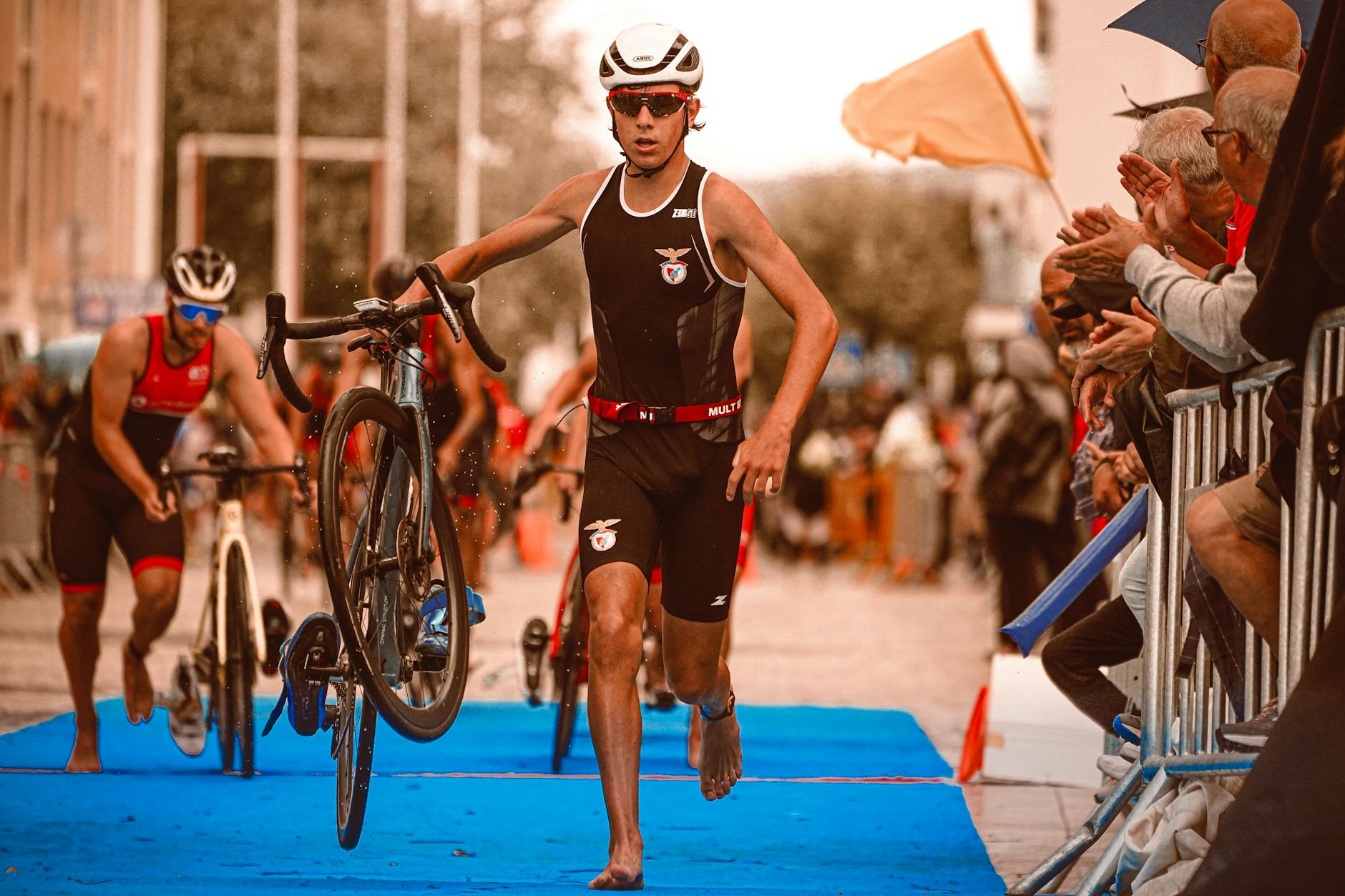
Triathlon training schedule for beginners
Mastering Transitions
Transitions can make or break your triathlon performance. By mastering this crucial element, you’ll shave valuable minutes off your overall time. Let’s dive into the key aspects of nailing your transitions.
A. Setting up your transition area
Your transition area is your race day command center. Here’s how to organize it effectively:
- Set up your gear in the order you’ll use it
- Use a brightly colored towel as your base for easy spotting
- Arrange shoes with elastic laces for quick changes
- Place nutrition and hydration items within easy reach
| Item | Position | Purpose |
|---|---|---|
| Bike | Racked securely | Ready for quick mount |
| Helmet | On handlebars | Easy to grab and go |
| Sunglasses | Inside helmet | Protection for cycling |
| Running shoes | Open, with elastic laces | Quick change for run |
B. Practicing efficient transitions
Efficiency comes with practice. Incorporate these drills into your training:
- Simulate swim-to-bike transitions in your backyard
- Practice mounting and dismounting your bike at speed
- Time your transitions and aim to improve each session
C. Time-saving transition tips
- Use body markings or tri tattoos for quick race number visibility
- Wear your race belt under your wetsuit for a faster T1
- Leave your bike in an easy gear for a smooth start
- Use speed laces or elastic laces on your running shoes
By focusing on these transition strategies, you’ll move seamlessly between disciplines, giving you a competitive edge. Now that you’ve mastered transitions, let’s explore the crucial aspects of nutrition and hydration to fuel your triathlon journey.
Triathlon training schedule for beginners
Tapering and Race Preparation
As your big day approaches, it’s crucial to understand the importance of tapering and proper race preparation. Let’s dive into the key aspects that will set you up for success in your first triathlon.
Understanding the Taper Phase
Tapering is a critical period in your triathlon training where you gradually reduce your training volume to allow your body to recover and peak for race day. Here’s a breakdown of an effective taper strategy:
| Week | Training Volume Reduction |
|---|---|
| 3 | 20-30% |
| 2 | 40-50% |
| 1 | 60-70% |
Mental Preparation Strategies
Mental preparation is just as important as physical training. Consider these techniques:
- Visualization: Imagine yourself successfully completing each leg of the race
- Positive self-talk: Develop a mantra to repeat during challenging moments
- Goal setting: Establish realistic expectations for your first triathlon
Race Week Checklist
Ensure you’re fully prepared with this essential race week checklist:
- Pack your gear bag (swimsuit, goggles, bike, helmet, running shoes)
- Review the course map and transition areas
- Check your bike’s condition (tires, brakes, gears)
- Prepare your nutrition and hydration supplies
- Get plenty of rest and stay hydrated
Pre-race Routine
Establish a pre-race routine to calm your nerves and set yourself up for success:
- Wake up early to allow ample time for preparation
- Eat a light, familiar breakfast
- Arrive at the venue with plenty of time to spare
- Set up your transition area methodically
- Warm up gently to loosen your muscles
By following these guidelines, you’ll be well-prepared for your first triathlon. Next, we’ll discuss how to execute your race day plan effectively.
Triathlon training schedule for beginners
Triathlon training schedule for beginners
Race Day Execution
Managing race day nerves
As you approach your first triathlon, it’s normal to feel a mix of excitement and anxiety. To calm your nerves:
- Arrive early to familiarize yourself with the venue
- Follow a pre-race routine to center your thoughts
- Practice deep breathing exercises to reduce stress
- Visualize a successful race to boost confidence
Pacing strategies for each discipline
Proper pacing is crucial for a successful triathlon. Here’s a breakdown for each discipline:
| Discipline | Pacing Strategy |
|---|---|
| Swim | Start slow, gradually increase pace |
| Bike | Maintain steady effort, avoid surges |
| Run | Begin conservatively, finish strong |
Triathlon training schedule for beginners
Overcoming common race day challenges
During your first triathlon, you may encounter various obstacles. Here are some tips to overcome them:
- Equipment malfunction: Carry basic repair tools and know how to use them
- Nutrition issues: Stick to your practiced nutrition plan, but be flexible
- Weather changes: Prepare for various conditions and adjust your strategy accordingly
- Mental fatigue: Break the race into smaller segments and focus on one at a time
Remember, your first triathlon is about finishing and gaining experience. Stay focused on your goals and trust in your training. With these strategies in mind, you’ll be well-prepared to tackle any challenges that arise during your race. Next, we’ll recap key points to ensure you’re fully prepared for your triathlon journey.

Starting your first triathlon journey is nothing short of awesome and ambitious. If you follow the training schedules and strategies laid out in this guide, then you will have a solid foundation to face each discipline with confidence. You have some great advice to get you started from creating a good endurance base, practicing transitions and dialing in on key-race day execution.
As we get closer to actually competing in the event, it is important for us to stay not only physically strong but mentally resilient as well and remember; A triathlon demands more than just following a fluent pattern of back-to-back swimming, running & biking within a day, continuing until you cross that finishing line. With continued learning congratulate yourself on the small wins and those difficult lessons that often are called setbacks. Then, with hard work and dedication on your part — the finish line is crossed in satisfaction (most of the time) knowing that you can do this for another season. So, now you know what to do with that knowledge and how it starts your journey as a triathlete!
